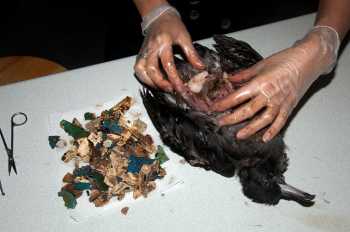Maria Cristina Fossi (Department of Physical Sciences, Earth and Environment, University of Siena, Italy) and colleagues have reviewed plastic ingestion and entangled in cetaceans and Near Threatened Flesh-footed Shearwaters Ardenna carneipes in the open-access Frontiers in Marine Science.
The paper’s abstract follows:
“Impacts of debris on marine fauna occur throughout the marine ecosystems, with adverse impacts documented on over 1,400 species; impacts can be divided into those arising from entanglement, and those from ingestion. Ingestion of, and entanglement in, debris has been documented in over 60% of all cetacean species. Seabirds are also impacted by debris predominately through entanglement and ingestion, with the number of species negatively impacted increasing from 138 to 174 over the past two decades. In the marine environment, cetaceans and seabirds are widely regarded as reliable sentinels due to their position near the top of the marine food web, conspicuous nature, and reliance on marine resources; for this reason, this paper is focused on seabirds and cetaceans as sentinels of ocean change. In particular, two case studies are considered in relation to different levels of environmental anthropogenic impact: the cetaceans of the Mediterranean Sea and seabirds of eastern Australia. Here we describe two recent studies used to diagnose the toxicological stress related to debris-associated pressures in cetaceans and seabirds. These studies highlight the diversity and scale of impacts being felt by marine species and the role these organisms can play in our society as charismatic sentinels of ocean health. Seabirds and marine mammals are exposed, in these key areas, to a variety of adversities that potentially decrease their survival or reproductive success. These include weather, food shortages, predators, competitors, parasites, disease, and human-induced effects and plastic pollution. Each factor affects seabirds and marine mammals in a different way, but more importantly, factors can also interact and create impacts far greater than any one factor alone. The Australian and Mediterranean case studies presented here emphasize the need to consider multiple sources of mortality when developing management plans for the conservation of vulnerable species.”

Plastic fragments get removed from the gut of a Flesh-footed Shearwater, photograph by Ian Hutton
Reference:
Fossi, M.C., Panti, C., Baini, M. & Lavers. J.K. 2018. . A review of plastic-associated pressures: cetaceans of the Mediterranean Sea and eastern Australian shearwaters as case studies. Frontiers in Marine Science doi.org/10.3389/fmars.2018.00173/.
ACAP Information Officer, 04 June 2018

 English
English  Français
Français  Español
Español